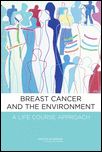SABCS: IOM Report Finds No Easy Solutions for Reducing Environmental Risk Factors
Although some preventive steps can now be taken by women to reduce environmental factors that contribute to breast cancer risk, much more research is needed to clarify the role of recognized and suspected environmental factors, according to a new report issued by the Institute of Medicine.
SAN ANTONIO-Although some preventive steps can now be taken by women to reduce environmental factors that contribute to breast cancer risk, much more research is needed to clarify the role of recognized and suspected environmental factors, according to a new report issued by the Institute of Medicine (IOM). Authors of the report, titled "Breast Cancer and the Environment: A Life Course Approach," say more work also needs to be done to effectively convey prevention-oriented research findings to patients, health care providers and public health decision makers.

"Some of the strongest evidence reviewed supports a causal association between breast cancer and ionizing radiation," the report says. "However, population exposures to ionizing radiation in medical imaging are increasing." Although standards are in place to ensure that mammography minimizes radiation exposures, more needs to be done to minimize exposures from other procedures. Thus, the report recommends that the National Institutes of Health, the US Food and Drug Administration, and the Agency for Healthcare Research and Quality "should support comparative effectiveness research to assess the relative benefits and harms of imaging procedures and diagnostic/follow-up algorithms in common practice." This research should also assess ways to "fill the knowledge gaps" among patients, providers, and regulatory authorities so as to minimize exposure to radiation from diagnostic procedures.
Some of the potentially risk-reducing-but not necessarily easily accomplished-measures identified in the report are familiar lifestyle modifications, such as avoidance of active and passive smoking, limiting alcohol consumption, maintaining a healthy weight, and exercising regularly. "Some breast cancer risk factors appear to be modifiable, but it is important to determine what modifications can be most effective in reducing risk and when during the life-course these changes need to occur," the report says. "For example, overweight and obesity are recognized as increasing risk for postmenopausal breast cancer, but the contribution of weight loss to reducing risk is much less clear."
The report, issued by the IOM’s Committee on Breast Cancer and the Environment, provides a detailed review of scientific research regarding environmental factors that may affect breast cancer risk. Chemicals identified as likely contributing to risk include benzene, 1,3-butadiene, and ethylene oxide, found in some workplace settings as well as in gasoline fumes, vehicle exhaust, and tobacco smoke. Limited or contradictory findings support a role for other chemicals of concern including bisphenol A (BPA), pesticides, various ingredients used in cosmetics, and dietary supplements. Women may choose to minimize exposure to these chemicals but the committee found the research inadequate to conclude that it is beneficial to do so.
The report recommends that future research target areas where there is provocative but as yet inconclusive evidence that warrants priority attention. These include the effects of overnight shift work and disruption of the sleep cycle; chemicals that cause gene mutation, alter gene expression, or effect hormones such as estrogen; and gene-environment interactions.
"Important targets for research are the biologic significance of life stages at which environmental risk factors are encountered, what steps may counter their effects, when preventive actions can be most effective, and whether opportunities for prevention can be found for the variety of forms of breast cancer," the report concludes.
"Breast cancer develops over many years so we need better ways to study exposures throughout women’s lives, including when they are very young," said committee chair Irva Hertz-Picciotto, PhD, MPH, from the division of environmental and occupational health, University of California, Davis. "We also need improved methods to test for agents that may be contributing to breast cancer risk and to explore the effects of combined exposures."
Established in 1970 under charter of the National Academy of Sciences, the IOM provides independent, objective, evidence-based advice to policymakers, health professionals, the private sector, and the public. The study was supported by Susan G. Komen for the Cure. Copies of "Breast Cancer and the Environment: A Life Course Approach" are available online at www.nap.edu.